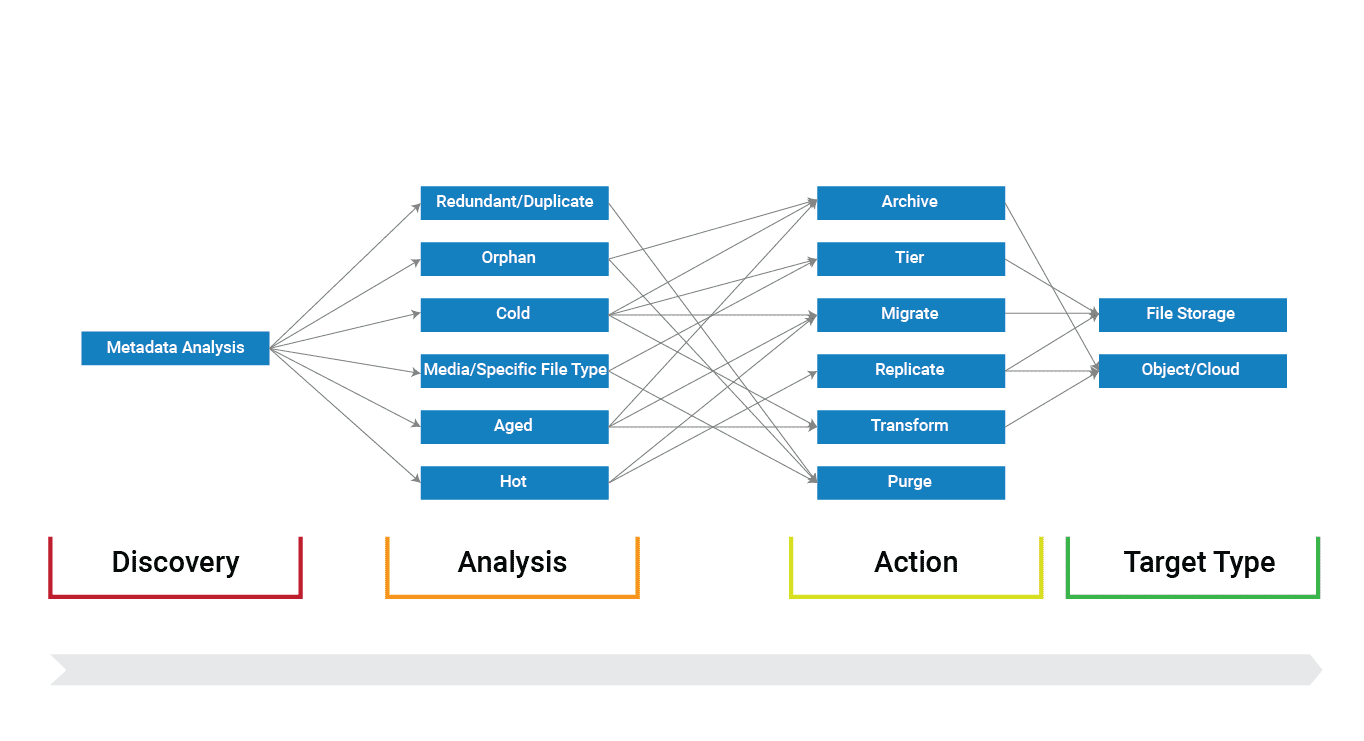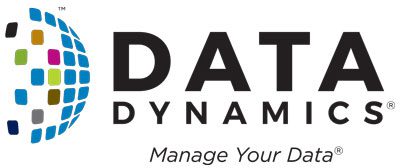StorageX Operation Workflow

The overall workflow for our StorageX product has three essential steps, regardless of what your company does, how much data you have, or where you store that data:
- Discovery: Get information about your data, pulling from across your network and in multiple locations worldwide, if necessary.
- Analysis: Understand what types of data you have, where it’s stored, what format it’s stored in, and how much of it you have.
- Action: Do something with that data you’ve analyzed; does it need to be stored where you have it now? Is it duplicated data? Is it as secure as it should be? Can you save your company money by moving it or getting rid of it?
Discovering Your Data
Businesses run on data. They always have, from the first time a scribe carved the amount of grain received from a merchant on a stone tablet. The only real difference across the centuries is the medium – we’ve gone from stone, wood, and papyrus to filing cabinets full of paper churned out by typewriters and copiers to all-digital filing systems where few things are rarely ever printed out.
It’s the same data, but in a different form, and like those filing cabinets crammed with pages, we now have servers and servers full of documents, spreadsheets, presentations, charts, and every other conceivable form of information.
In the modern era, every single enterprise gathers data of one type or another, from every office, employee, customer, and supplier. That data all needs to go somewhere, so we save it and store it; unfortunately, we then sometimes forget about it, or misplace it, or copy it three hundred times across an entire network of servers. Just like those old filing cabinets, we have filing systems that sometimes let you find things and sometimes are a complete mess.
This profusion of data, scattered throughout your enterprise, comes with a cost. Unnecessarily duplicated files eat up your storage space, which obviously costs money when you need to pay to expand, and potentially more importantly, files that are misplaced or simply can’t be found cost you in terms of time and effort, both to search for those files and recreate them if necessary.
The above is why the first step in the StorageX workflow, the discovery step, while it may be simplest in terms of the workflow itself, is also the most critical. You cannot know what you need to do with your data until you find your data, after all.
Using the StorageX Management Portal, you can scan all or part of your enterprise environment, across a wide range of different operating systems and storage types, to get concrete, current, detailed information about your data, and stores that information in a queryable repository to be used in the next steps of the workflow.
Analyzing Your Data
With the above in mind, information without context is useless – it only adds to the data clutter, which is what we want to address in the first place.
That means that to truly get a handle on your data, you need to analyze it. StorageX provides you with the tools to dig down into your data, using the file metadata to determine where your files live, how old your files are, what type of files they are, and how important they are.
Once you have scanned one or more of your storage resources, the StorageX Management Portal lets you view all the data on those resources, giving you a holistic overview of your environment, and in both “raw” tabular format or in one of several easy-to-understand analysis reports, including reports on the size of your files, the age of your files, how often your files are accessed or modified, and which users consume the most storage. You can also build queries in StorageX to selectively view the data in your environment that you’re most interested in.
Taken together, this functionality lets you learn about your overall storage environment, and can provide insight in the following areas:
- Redundant/Duplicate Data: What redundant, unnecessary data is just taking up valuable space on your servers? How many duplicates do you have of one specific presentation or video file, which was inadvertently shared and downloaded across the company?
- Orphaned Data: What data on your servers is left over from a previous corporate merger, or from an employee who left the company five years ago, and is no longer needed?
- Cold Data: What data do you have that’s “cold”, that no one in your enterprise has touched or looked at in several years, and where is that data stored right now?
- Hot Data: Similarly, what data is “hot”, where your team is using it or looking at it regularly, and where is that stored?
- Media/Specific File Types: What types of data are taking up the most space on your servers? Is there a giant pile of old video files stored somewhere, or sets of seismic images, or dense architectural renderings?
- Data by Age: How old is your data in general, across your enterprise?
Taking Action
This brings us to the third step in the StorageX workflow: action. Now that you know where your data is, what kind of data it is, how often it’s being accessed or used, how large it is, and how critical it is, you can then decide what to do with it.
Here the possibilities are nearly limitless, all depending on your data and the needs of your enterprise. If you found a lot of redundant files that take up a lot of space, for example, then you most likely want to just delete those files, get rid of them entirely.
On the other hand, if you learned from your analysis in StorageX that your employees use a certain set of files very often, and those files are currently stored on an old, under-powered server, you might want to move those files to a different, more highly performant server in your lab.
In most cases, when you act on your data, those files are going to go somewhere – that’s where the target type comes in. StorageX works across a wide range of different file-based and cloud-/object-based platforms and applications, allowing you to move, copy, or archive your data, depending on your needs, from file servers to object storage and back again.
StorageX provides several different options for optimizing your data:
- Archive: In nearly every industry, enterprises are moving data to object storage – into the cloud. One primary reason for moving to object storage is for your old, unused, or “cold” data; cloud object storage can be a cost-effective way to store that data when you no longer need to access it as frequently. StorageX gives you a streamlined way to take your analyzed data and archive those specific files you want to move to object storage.
- Tier: Faster, higher-powered servers can be expensive both to purchase and maintain, so you need to be very thoughtful when storing data on those types of servers. You may want to move less-frequently-used files to a lower-powered group of servers in your environment, while the more regularly accessed files need to be on servers with high I/O, plenty of disk space, and more processing power. StorageX lets perform workload tiering, using the results of your analysis to determine which files need to go on which “tier” of your storage infrastructure.
- Migrate: If you have data on one file-based storage resource and need to move it to another, you can use StorageX to migrate that data. This can be useful if you have upgraded your lab, adding new servers, and now need to clean off the old servers so you can get rid of them. You could also be changing providers in terms of your file storage, moving from one company’s filers to another because you can get better performance from the new filers. Migration is a one-way copy of your files, moving them fully and completely and leveraging DFS namespaces to redirect traffic from the source to the destination to provide a seamless experience for your users.
- Replicate: Maybe you don’t want to move your data fully from one resource to another, but instead want to copy important files or objects in multiple places in case of a power or network outage. In that case, you can replicate files to an object store or objects from one object store to another, keeping the original on the source.
- Transform: While scanning and analyzing your data is a good thing, you may not always need to do that every time. In some situations, you want to move not just some of your files to object storage, but an entire application at a time, without worrying about analyzing all of it to see what is located on which server. StorageX enables you to transform your existing file data all at once, copying that data behind-the-scenes to a specified object store.
- Purge: Finally, sometimes you just need to delete old, unused, redundant data. StorageX can help you to find that data and then purge it from your storage environment entirely, freeing up valuable space and reducing your overall storage costs.
Click Here to know more about FREE migrations into Azure or contact us at azure@datdyn.com/(713)-491-4298
For more information on Data Dynamics, visit https://www.datadynamicsinc.com/
Get Started
